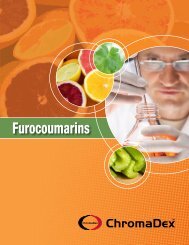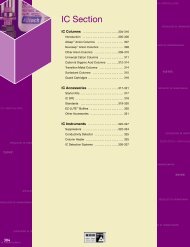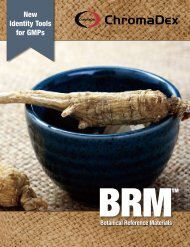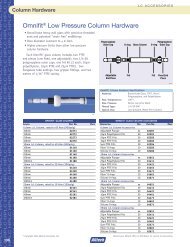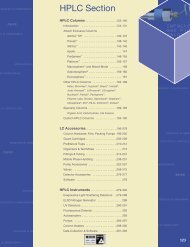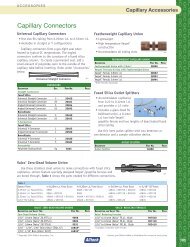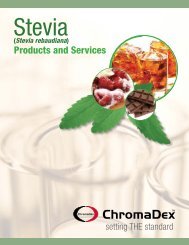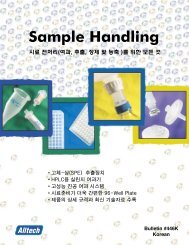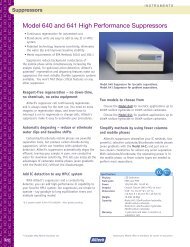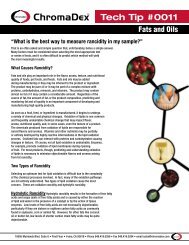Grace Catalog 2008
Grace Catalog 2008
Grace Catalog 2008
Create successful ePaper yourself
Turn your PDF publications into a flip-book with our unique Google optimized e-Paper software.
prep | flash | tlc<br />
tlc<br />
TLC Introduction<br />
Thin Layer Chromatography to Preparative<br />
Chromatography<br />
One of the first steps in scale-up of preparative liquid<br />
chromatography separations is selection of an appropriate<br />
mobile phase. Two methods are commonly used to<br />
determine the proper mobile phase composition: Thin<br />
Layer Chromatography (TLC) or High Performance Liquid<br />
Chromatography (HPLC). The use of TLC will be discussed<br />
here to deal with the successful correlation between the TLC<br />
separation to the preparative silica column.<br />
TLC is a liquid-solid adsorption technique where the mobile<br />
phase ascends the thin layer of stationary phase coated onto<br />
a backing support such as glass by capillary action. There<br />
is a similar relationship to column chromatography where<br />
the solvent travels down through the column’s adsorbent.<br />
The similar relationship allows TLC to be a rapid method for<br />
determining solvent composition for preparative separations.<br />
Steps for Method Development<br />
Choose Stationary Phase<br />
Choose a scalable TLC plate, preferably that has an identical<br />
media as the preparative column. Choose between normal<br />
and reverse phase based on sample polarity and solubility.<br />
Choose a Mobile Phase<br />
Criteria for Choosing a Preparative Solvent<br />
• Solubility<br />
• Affinity<br />
• Resolution<br />
1. Solubility<br />
Many solvent systems provide the minimal solubility for the<br />
sample, but to elute a sample from a column the mobile<br />
phase must have a greater solubility for the sample, as the<br />
sample concentration is usually very high. When possible, it<br />
is best to dissolve the sample in the mobile phase. The first<br />
step in solvent selection is determination of the solubility of<br />
the sample. The desired mobile phase would provide the<br />
greatest solubility, while providing affinity for the sample on<br />
the stationary phase.<br />
Solvent Solubility Screening Table<br />
Water<br />
Methanol<br />
Ethanol<br />
Acetone<br />
Diethyl Ether<br />
Ethyl Acetate<br />
Dichloromethane<br />
Toluene<br />
Chloroform<br />
Cyclohexane<br />
Petroleum Ether<br />
Hexane<br />
Increasing Polarity<br />
2. Affinity<br />
To achieve a separation, the sample must have a relatively<br />
equal affinity for the solvent and the packing material. If the<br />
sample has a higher affinity for the stationary phase than the<br />
solvent, the sample will remain at the origin (Rf value will be<br />
too low).<br />
3. Resolution<br />
Resolution is improved by optimizing the affinity between<br />
sample, solvent, and support. The optimum solvent for<br />
separating two or more compounds will maximize the<br />
difference in the compounds. Most TLC and preparative<br />
mobile phase systems contain a polar solvent and a<br />
chromatographically dissimilar less-polar solvent. As a<br />
guide for method development, a substitution in the polar<br />
solvent often results in a change in resolution, while a change<br />
in the less-polar solvent results primarily in a change in Rf<br />
of the sample components. The table below shows some<br />
common tendencies of various functional groups to adsorb<br />
onto the silica.<br />
Affinity of Functional Groups for Silica Gel<br />
-NH2 Amine<br />
-COOH Carboxylic Acid<br />
-COH Alcohol<br />
-CONH2 Amide<br />
-C=O Carbonyl<br />
-C=-CO2R Ester<br />
-C-O-C Ether<br />
-C1 Halocarbons<br />
-CC- Hydrocarbons<br />
Select Visualization Technique<br />
Once a mobile phase is selected, visualization techniques<br />
will need to be determined. Common techniques include<br />
SWUV, I2 /SWUV, I2 /KI for Nitrogen containing compounds,<br />
H2SO4/LWUV, H2SO4/PMA for non-nitrogen containing<br />
compounds.<br />
Perform TLC Analysis<br />
Increasing Affinity<br />
Look up the affinity for the type of compound as well as<br />
the solvent strengths to find a starting point for method<br />
development or look up a reference from a similar structure,<br />
then adjust the mobile phase composition to adjust the Rf. It<br />
is common to try 3–6 solvent systems for the first round of<br />
method development. Review the results after visualization<br />
and adjust the Rf if necessary, increase the separation and<br />
evaluate visualization techniques to make sure you are seeing<br />
all necessary compounds.<br />
Optimizing TLC Separations for Preparative<br />
Separations<br />
The optimum separation of compounds by TLC is usually<br />
achieved when Rf values are between 0.3–0.5.<br />
Rf = Distance from origin to center of spot<br />
Distance from origin to solvent front<br />
Generally, adjusting the compound’s Rf between 0.3–0.5 is<br />
done first for a TLC separation. For scale-up to preparative<br />
separations, the TLC solvent system’s polarity must be<br />
decreased to lower the Rf between 0.15–0.35. This Rf range<br />
is optimal for a preparative separation, in terms of sample<br />
load, resolution, residence time, and solvent usage.<br />
Determination of Column Volumes (C.V.)<br />
The equation C.V. = 1/ Rf relates the TLC values and the<br />
preparative LC column volumes to elute each component.<br />
This equation is only a guideline and the relationship<br />
between the Rf values and the column volume will vary in<br />
use. Generally, the LC column volumes will be equal to or<br />
less than the calculated values. The elution volume will also<br />
be dependent upon the sample load and solvent used to<br />
solubilize the sample.<br />
188 www.discoverysciences.com




